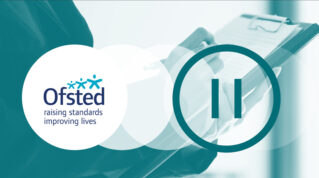Ofsted has heralded “sustainable improvements in education” but warned of growing pressure on the SEND system and “misuse” of alternative provision.
Amanda Spielman’s final annual report in her role also revealed more ‘outstanding’ schools kept their grades last year following what the chief inspector called a “wake-up call” when the exemption was lifted two years ago.
Here’s what we learned. Freddie Whittaker, Amy Walker and Samantha Booth report.
1. More schools ‘good’ or better, but fewer ‘outstanding’ …
Ofsted inspected 7,240 state schools in the year to August 31, up from 4,670 in 2021-22 and the highest number in five years.
Ninety per cent of previously ‘good’ schools remained at that grade or improved, and 75 per cent of schools that were previously ‘requires improvement’ were rated ‘good’ or ‘outstanding.
Ninety-seven per cent of previously ‘inadequate’ schools improved.
Nationally, 89 per cent of schools are now judged ‘good’ or ‘outstanding’.

However, the proportion of ‘outstanding’ schools nationally decreased from 18 to 16 per cent last year, while the proportion rated ‘good’ increased from 70 to 73 per cent.
2. …more ‘outstanding’ schools keep grade after ‘wake-up call’
Between 2012 and 2021, ‘outstanding’ schools were exempt from routine inspection. When the exemption was lifted, large numbers of schools were downgraded. But they were less likely to lose their top grade last year than the year before.
In 2022-23, 16 per cent of primary schools and 31 per cent of secondaries kept their ‘outstanding’ grade, up from 14 and 24 per cent respectively in 2021-22.
Schools that had gone the longest without an inspection were prioritised. Spielman said today: “I think that first year of inspections probably came as a bit of a wake-up call that made a lot of people really take a look”.
So far, 760 previously exempt schools have lost their ‘outstanding’ grade, while 160 schools have been upgraded to the top rating.
3. Fewer schools eligible for intervention
The number of schools eligible for intervention by the government due to their performance has fallen, despite a change that brings schools rated ‘requires improvement’ twice in a row into scope.
Since last September, such “coasting” schools have also been at risk of academisation or rebrokering to a new sponsor.
But the number of schools eligible for intervention has actually gone down – from 1,610 in 2021-22 to 1,340 in 2022-23.
4. Schools’ ‘deeper’ curriculum thinking helped catch-up …
The outgoing chief said she had seen “sustainable improvements in education” in her time in office.
She claimed that a “deeper thinking about curriculum undoubtedly helped when the pandemic hit”.
“My view was that for most children, most catch-up would happen in their normal classrooms, with their normal teachers – and that seems to have been the case.”
5. …and they are ‘rising to the behaviour challenge’
The report stated that “even though schools report deteriorating pupil behaviour since the pandemic, inspection judgements for behaviour and attitudes show a largely positive picture in schools”.
Of 3,720 schools given a graded inspection this year, 73 per cent were judged good and 17 per cent outstanding on behaviour and attitudes.

This “shows that many schools are rising to the challenges they are facing”. But the picture is “very different between primary and secondary schools”.
Ninety-three per cent of primary schools were judged good or outstanding for behaviour and attitudes compared with 76 per cent of secondary schools.
6. Nearly a third of areas ‘failing’ on SEND …
A new area SEND inspection framework launched in January. Sixteen areas have been inspected, with five receiving the lowest rating of “widespread and/or systemic failings”.
Ofsted said the growing number of pupils with SEND has put “added pressure” on mainstream and special schools. The rise in the number of education, health and care plans “is having a negative impact on health and education services”.
Some schools are using part-time timetables for children waiting for a special school place, often “for those with behavioural needs”, which is not always in their “best interests”.
7. …and AP used as a ‘shadow SEND system’
The shortage of special school places means alternative provision is “sometimes used as a shadow SEND system”, the report warned.
Some schools use it as a “last resort, with many using AP for crisis management rather than as a suitable long-term placement for a child”.
Inspection outcomes are worse for state-funded AP than for other state schools, with 83 per cent judged good or outstanding last year, compared to 88 per cent of all schools.
Ofsted said it would “increase scrutiny of the misuse of AP”.
The number of AP placements has increased by 13 per cent from 59,900 in January 2022 to 67,600 this year.
Ofsted said the proportion of young children in AP is also rising, with 21 per cent of pupils aged under 11 – a 15 per cent increase from last year.
8. Short inspections ‘restrict professional dialogue’
Ofsted has been reviewing the implementation of its current inspection framework, which was introduced in 2019. The review found it was being implemented “largely as intended, and that the framework is flexible across a range of provision types”.
But “we have identified some areas where implementation is challenging”.
“For example, although we have sufficient time to come to valid judgements, inspectors recognise that in ungraded school inspections in particular, the limited time they have can restrict the professional dialogue with leaders and others more than is desirable.”
The main fundings will be published “shortly” and an impact evaluation will be conducted next year.
9. Improving picture for ITT
A new framework for inspecting initial teacher education was introduced in 2021.
In the year to August 31, Ofsted inspected 110 providers. Around nine in 10 were ‘good’ or ‘outstanding’, up from around six in 10 of those inspected in the year before.
Overall, 96 per cent of providers are now judged ‘good’ or ‘outstanding’, up from 94 per cent a year ago, but down from 100 per cent before the new framework was introduced.
By August 2024, all registered ITE providers will have been inspected under the current framework.

















Ofsted spokesperson: “Children only get one chance at education, and inspection ensures the standards are high for all children,”
They don’t, of course. Otherwise, why would we spend money on further education where children get at least a second chance.
More than that, Ofsted too often comes along “after the fact”; that is, when children are already enduring an inadequate education. Think of all those children in allegedly “outstanding” schools that weren’t inspected for up to 11 years later…when quality had declined and children’s “one” chance had been lost!
There needs to be investment in much more frequent checks by a body that can be held accountable locally, and which can act rapidly to help schools remedy their weaknesses.
Too little and far too late. Our young people with additional needs have been failed continously by the system.
Early help is non existent.
The system is still in a a state of picking up the pieces rather than being proactive.
Can’t blam a mainstream school for “failing” children with behavioural and educational special needs – if the child’s needs woul be better met in a special needs school but there’s no places. Or parents decided not to take a place.
Thi is a calculated and immoral policy, to cut Sen school places and push children into mainstream.
First lot, the child may not benefit and lose out on learning life skills at their attainment level and at their pace. They can be overwhelmed in a big classroom with 30+ kids.
No staff in a mainstream setting, even with the best experience, best plans, best discipline, best resources and best team work can make up for a proper special needs school environment.
Secondly, every child loses out as behaviours can lead to constant disruption, time spent on health and safety and immediate risk mitigation instead of having time and meaningful interactions for education purposes with all the other children in class.
Thirdly, there is a balance of the rights to a child to access mainstream and the rights of another child to have undisrupted education, play and interactions. Government seems to have supported a push into the “shadow” SEN mainstream – and by stealth unfunded SEN school places that would be of much more benefit for some children.
Fourth, the wages in SEN by no means reflect the intensity, effort, patience, resilience and exhaustion levels in that workforce cohort.
It is a job for part time work mums who have to work around childcare, school holidays and sickness. It is of little surprise that jobs are not taken up if stacking tins pays more and has same flexible hours.
So – we need a good, hard look at SEN, appropriate place provision and appropriate educational attainment for all children.
Staff cannot keep spending time on unsafe and disruptive behaviours that force them to ignore all other needs and questions in the room.
You are assuming in your comment that all Children with SEN are disruptive. Many are not any more or less disruptive than those without SEN. Many will never be disruptive in School & mask to conform. Many with SEN are very academically able & the vast majority of SEN Schools do not provide the same choice of GCSE’S. Some don’t provide any beyond functional skills & life skills. The SEN world is as varied as the MT world. Mainstream School is absolutely the right place for many & absolutely the wrong place for others. Though this is more to do with a one size fits all approach that suits no-one. Not the ND or SEN cohort any more than the NT cohort. It has much more to do with the School environment, lack of Staff, class numbers & rigidity as well as punitive punishments for forgetting a pen , or not doing up a top button. The nurturing, holistic Child centered approach is sadly lacking in many Schools. Inclusivity is about understanding & reasonable adjustments & equity in law not equality. Reasonable adjustments are often misunderstood. They don’t have to be huge. Often the smallest adjustments can make the biggest difference. The single overwhelming issue in Schools is lack of training. Lack of training not just on SEN but on disabilities, Trauma & mental health.
Teachers do not have to be experts in these fields but they do need to have a basic understanding. Until Teachers receive mandatory uniform regular training on SEN then things will never improve. I find it utterly shocking that a SENCO can be in post without any training in SEN. Most Parents believe that they have received extra training & in fact are experts on the subject. This couldn’t be further than the truth. The NT community aren’t without their issues many are dealing with health conditions, Trauma, poverty etc & of course those who have SEN may be dealing with both. The NT brain has much to give. Huge amounts of insight on the world around us, creativity & often a strong sense of injustice. Society could learn a lot. Many NT Children go on to become very high achievers if they are given the tools to do so. They are not less than. You will probably gather from this that I am a Parent of 3 amazing Children all of whom have so far achieved great things. All had different needs because we are all different. My two youngest both got extremely high marks in their GCSE’s & passed all. One was a Prefect. Both took part in School plays. One not only took part but made & sourced costumes for it. One got an A in an AS level. Her School is using her exam papers to teach other students. One is now at College, the other has an amazing Apprenticeship in Journalism. My eldest at the age of 16 became RSM of his County in Army Cadets, got his Champion & master Cadet. Had his own house at 20. My Children had/have SEN varying from Dyslexia to being Autistic. My girls found School very hard because of the environment inducing anxiety, constant change with little notice & sensory issues amongst others. But let’s be clear they contributed to the Schools academic achievements & standing. Their behaviour was excellent & empathetic. Should they have gone to a SEN School absolutely not it was not the right environment for them. Mainstream School with lots of support was. SEN Children are no more or less disruptive than NT Children. When they are disruptive it is often because they are misunderstood. There are Schools that understand Inclusion & do it well. Others do not. We need to change how we do things & adapt the School environment to suit. Society & Schools have much to learn from our Children. They do not deserve to be forced into an environment that doesn’t suit their needs whether that be a mainstream or a SEN School..I cannot thank my Children’s Teachers enough for their inclusive approach. I am very sad that others do not have the same. The Pandemic is often sited as the reason for an increase in mental health issues though it was going wrong long before the Pandemic with increasing numbers of Children forced out of mainstream & with no School place. If simple reasonable adjustments had been made & some understanding of SEN then many would still be in School. Society is failing our Children & it’s only going to get worse unless they have a complete re-think about how are education system works for all. Every Child deserves to reach their full potential period.